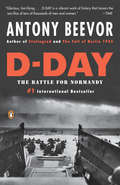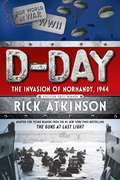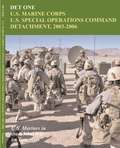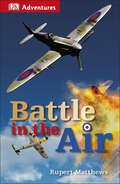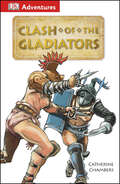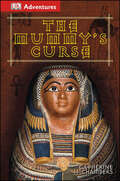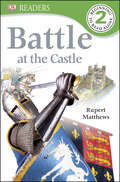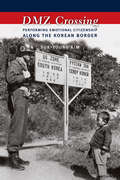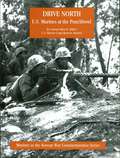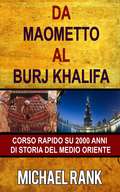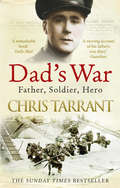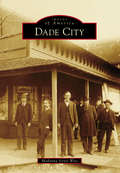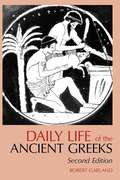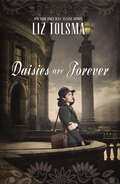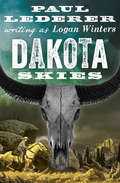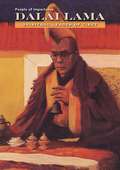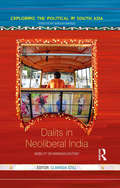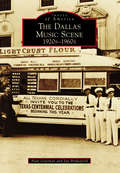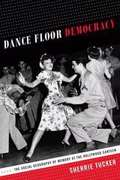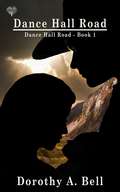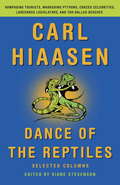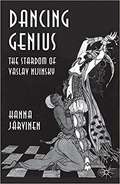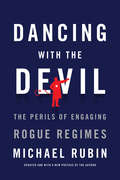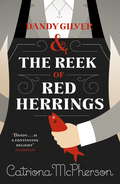- Table View
- List View
D-Day: The Battle for Normandy (Litterature & Documents Ser.)
by Antony Beevor<p>Renowned historian Antony Beevor, author of <i>Stalingrad</i> and <i>The Battle of Arnhem</i>, and the man who "single-handedly transformed the reputation of military history" (The Guardian) presents the first major account in more than twenty years of the Normandy invasion and the liberation of Paris. <p>This is the first book to describe not only the experiences of the American, British, Canadian, and German soldiers, but also the terrible suffering of the French caught up in the fighting. Beevor draws upon his research in more than thirty archives in six countries, going back to original accounts and interviews conducted by combat historians just after the action. <p><i>D-Day</i> is the consummate account of the invasion and the ferocious offensive that led to Paris's liberation.</p>
D-Day: The Invasion Of Normandy, 1944
by Rick AtkinsonAdapted for young readers from the #1 New York Times–bestselling The Guns at Last Light, D-Day captures the events and the spirit of that day—June 6, 1944—the day that led to the liberation of western Europe from Nazi Germany's control. They came by sea and by sky to reclaim freedom from the occupying Germans, turning the tide of World War II. Atkinson skillfully guides his younger audience through the events leading up to, and of, the momentous day in this photo-illustrated adaptation. Perfect for history buffs and newcomers to the topic alike! <p><p> This thoroughly-researched and documented book can be worked into multiple aspects of the common core curriculum.
DET ONE: U.S. Marines in the Global War on Terrorism [Illustrated Edition]
by Lieutenant Colonel John P. PiedmontIllustrated with over 30 photos.The story of the Marine Corps U.S. Special Operations Command Detachment, which became known as Det One, is an extraordinary tale. On its face, the story would not rate a minute’s glance. One small group of Marines, about a hundred in number, formed, trained, and went to war. This all happened as the nation was 18 months into the Global War on Terrorism and as the Marine Corps was deploying I Marine Expeditionary Force in Operation Iraqi Freedom. Yet the story behind the basic facts is not only far more intricate and fascinating, with dramatic episodes and intrepid characters from the Pentagon to Camp Pendleton, it portended great significance for the Marine Corps.What makes the Det One story extraordinary is the shift in Marine Corps policy that brought it about, the maturation of the special operations capabilities of forward-deployed Marine expeditionary units that made it possible, and the patriotism, valor, fidelity, and abilities of the Marines and Navy Corpsmen who manned it. Although Det One has passed now into the history books, its legacy survives in the formation of Marine Corps Special Operations Command and in the lessons learned and experiences of its members, who now continue to serve in dozens of units.
DK Adventures: Battle in the Air (DK Adventures)
by Rupert MatthewsIn DK Adventures: Battle in the Air, Zoe and Zak discover a battered old metal box that belonged to their grandfather when he was in the Navy. As they look through the box, Granddad tells stories about the Battle of Britain and life during World War II. Through this compelling story, you can learn about the experiences of WWII Navy pilots, women's anti-aircraft gun crews, and how schoolchildren of the 1940s dealt with World War II. Now available in ePub format.DK Adventures is a book series that reluctant readers can enjoy as much as bookworms do! This series combines captivating, fictional stories with nonfiction facts to encourage learning and engagement in your child. The stories keep children interested, and the facts teach critical skills and knowledge--the fiction and nonfiction elements work together to keep each child's interest high, to build knowledge, and to enrich the narrative reading experience with fascinating background information. These books are filled with information, but the stories make them incredibly readable. DK Adventures are available in a range of kid-friendly topics, including dinosaurs, cars, and the human body, and each book supports Common Core State Standards and literacy skills.
DK Adventures: Clash of the Gladiators (DK Adventures)
by Catherine ChambersIn Clash of the Gladiators join DK Adventure's exclusive SLIP club (Secret Living In the Past) — a group of young history buffs who belong to a top-secret club that allows them to travel throughout history to any time, any place through a phone app. This time their journey takes them to Ancient Rome, where the mighty gladiators are getting ready to stage a huge spectacle at the Colosseum. But trouble is stirring at the amphitheater. Will the team manage to foil an evil scheme? More important, will they ever see home again? DK Adventures are an innovative mix of narrative and nonfiction for kids ages 8-11 featuring engaging, action-packed stories that help kids build their skills in vocabulary, grammar, comprehension, and critical thinking while developing a love of reading. With diaries, recipes, poetry, instructions, graphics, or songs, the genre spreads in each DK Adventures title enhance the story and reinforce curriculum learning, while the expansive range of entertaining nonfiction subjects will appeal to boys and girls everywhere. Supports the Common Core State Standards.
DK Adventures: The Mummy's Curse (DK Adventures)
by Catherine ChambersIn Mummy's Curse join DK Adventure's exclusive SLIP club (Secret Living In the Past) — a group of young history buffs who belong to a top-secret club that allows them to travel throughout history to any time, any place through a phone app, on their next action-packed adventure as they go back to Ancient Egypt to uncover the truth about the mummy's curse. Travel along the Nile and through the city of Memphis with Musa, Seth, and Luana and discover the secrets of the pyramids. Will the gods help them on their quest, or will they be cursed forever? DK Adventures are an innovative mix of narrative and nonfiction for kids ages 8-11 featuring engaging, action-packed stories that help kids build their skills in vocabulary, grammar, comprehension, and critical thinking while developing a love of reading. With diaries, recipes, poetry, instructions, graphics, or songs, the genre spreads in each DK Adventures title enhance the story and reinforce curriculum learning, while the expansive range of entertaining nonfiction subjects will appeal to boys and girls everywhere. Supports the Common Core State Standards.
DK Readers L2: Battle at the Castle (DK Readers Level 2)
by Rupert MatthewsThrough the letters of a squire of the knight Sir Edmund Perry, readers are immersed in the life at Oxney Castle in Medieval England. In Battle at the Castle children just beginning to learn to read will experience the excitement of a tournament, the preparations for an attack, and the action of the battle. Will help arrive in time to save the castle under siege? DK Readers is a multi-level reading program guaranteed to capture children's interest while developing their reading skills and general knowledge. With nine new exciting titles to choose from this season, kid's ages 4-10 will find the perfect book at their appropriate reading level to help with school projects or independent reading. Supports the Common Core State Standards.
DMZ Crossing
by Suk-Young KimThe Korean demilitarized zone might be among the most heavily guarded places on earth, but it also provides passage for thousands of defectors, spies, political emissaries, war prisoners, activists, tourists, and others testing the limits of Korean division. This book focuses on a diverse selection of inter-Korean border crossers and the citizenship they acquire based on emotional affiliation rather than constitutional delineation. Using their physical bodies and emotions as optimal frontiers, these individuals resist the state's right to draw geopolitical borders and define their national identity. Drawing on sources that range from North Korean documentary films, museum exhibitions, and theater productions to protester perspectives and interviews with South Korean officials and activists, this volume recasts the history of Korean division and draws a much more nuanced portrait of the region's Cold War legacies. The book ultimately helps readers conceive of the DMZ as a dynamic summation of personalized experiences rather than as a fixed site of historical significance.
DMZ Crossing: Performing Emotional Citizenship Along the Korean Border
by Suk-Young KimThe Korean demilitarized zone might be among the most heavily guarded places on earth, but it also provides passage for thousands of defectors, spies, political emissaries, war prisoners, activists, tourists, and others testing the limits of Korean division. This book focuses on a diverse selection of inter-Korean border crossers and the citizenship they acquire based on emotional affiliation rather than constitutional delineation. Using their physical bodies and emotions as optimal frontiers, these individuals resist the state's right to draw geopolitical borders and define their national identity.Drawing on sources that range from North Korean documentary films, museum exhibitions, and theater productions to protester perspectives and interviews with South Korean officials and activists, this volume recasts the history of Korean division and draws a much more nuanced portrait of the region's Cold War legacies. The book ultimately helps readers conceive of the DMZ as a dynamic summation of personalized experiences rather than as a fixed site of historical significance.
DRIVE NORTH - U.S. Marines At The Punchbowl [Illustrated Edition] (Marines In The Korean War Commemorative Series #3)
by Colonel Allan R. Millett USMCIncludes over 30 maps, photos and illustrationsThe Battle of the Punchbowl, was one of the last battles of the movement phase of the Korean War. Following the breakdown of armistice negotiations in August 1951, the United Nations Command decided to launch a limited offensive in the late summer/early autumn to shorten and straighten sections of their lines, acquire better defensive terrain, and deny the enemy key vantage points from which they could observe and target UN positions. The Battle of Bloody Ridge took place west of the Punchbowl from August-September 1951 and this was followed by the Battle of Heartbreak Ridge northwest of the Punchbowl from September-October 1951. At the end of the UN offensive in October 1951, UN Forces controlled the line of hills north of the Punchbowl.
Da Maometto Al Burj Khalifa – Corso Rapido Su 2000 Anni Di Storia Del Medio Oriente
by Michael Rank Eugenia FranzoniL'esperto giornalista e storico ottomano Michael Rank vi porta in questo emozionante nuovo libro una breve storia di 2000 anni di guerra, pace, rivolte religiose e collassi sociali in Medio Oriente.Per la maggior parte degli occidentali, il Medio Oriente e il conflitto israeliano-palestinese sono del tutto sconcertanti. I palestinesi vogliono bombardare gli israeliani, che li costringono con la forza delle armi a vivere in alcune parti ristrette della nazione. I leader arabi sono furiosi per questa situazione e vogliono che Israele sia "spazzato via dalle mappe", e che la terra sia restituita ai palestinesi, anche se le case della Terra Santa sembrano un po' la campagna dello Utah. Quasi tutti i leader mondiali vogliono mettere bocca in questa disputa tra le due minuscole terre.Per chiarire il conflitto del Medio Oriente moderno e i 2000 anni precedenti, questo libro è diviso in 25 brevi capitoli, ciascuno dei quali è dedicato ad un tema fondamentale della storia del Medio Oriente, come l'inizio dell'Islam, le crociate, Gengis Khan e la nascita di Israele nel 1948. Ognuno di essi può essere letto in pochi minuti, dandovi una rapida panoramica e aiutandovi a capire gli eventi che stanno accadendo in Medio Oriente.Dopo averlo letto, avrete una conoscenza del Medio Oriente pari a quella di un corso universitario di un anno, e potrete mostrare le vostre competenze su questo argomento ai vostri amici e colleghi.Se volete capire completamente questa parte del mondo in meno tempo possibile, allora "Da Maometto al Burj Khalifa" è il libro che fa per voi!
Dad's War
by Chris TarrantThe Sunday Times Top Ten BestsellerChris Tarrant and his father Basil were very close, they played sport together, watched sport together and shared the same sense of humour. Chris loved and admired his father but it was only after his death he realised that he hardly knew him at all … Basil Avery Tarrant grew up in 1920s Reading, where the smell of beer and biscuits from the local factories filled the air. He worked as an administrator in a local factory and spent his Saturday nights down at the music halls. But what happened to Basil during the war, and how he came to be awarded the Military Cross, remained a mystery to Chris and his family for nearly sixty years. In this emotional journey, Chris discovers that Basil was involved in some of WWII’s most significant campaigns, including the Dunkirk evacuation and the D-Day landings, and also took part in some of the most brutal, close-range fighting in Cleve. Dad's War is a profoundly moving and heartfelt tribute to a much-loved father, but it’s also a sincere and humble commemoration of the bravery and sacrifice of the soldiers of WWII.
Dade City
by Madonna Jervis WiseDade City was named for Maj. Francis L. Dade, who perished in the Dade Battle, which opened the Second Seminole War in 1836. As the county seat, formality intermingles with frontier roots in a revered, historic courthouse, a stately jail, and an array of churches and historic homes. Dade City entices visitors with antique shops, cafés, and historical architecture. Folks are drawn to the hospitality of the Kumquat Festival, the homespun county fair, and agricultural showcases at area ranches. In 1908, O. Henry included Dade City in one of his short stories as a symbol of Americana. Surrounding the historic town are alluring places that tell the stories of Florida: the Withlacoochee State Forest, Lake Jovita, Trilby, Lacoochee, and San Antonio to name a few.
Daily Life of the Ancient Greeks
by Robert GarlandSignificantly expanded and updated in light of the most recent scholarship, the second edition of Garland's engaging introduction to ancient Greek society brings this world vividly to life--and, in doing so, explores the perspectives and morals of typical ancient Greek citizens across a wide range of societal levels. Food and drink, literacy, the plight of the elderly, the treatment of slaves, and many more aspects of daily life in ancient Greece also come into sharp focus. More than sixty illustrations are included, as are maps, a chronology, a glossary of Greek terms, and suggestions for further reading.
Daisies are Forever
by Liz TolsmaIn the final days of Nazi Germany, the strength of one woman&’s heart will determine the fate of a family.Prussia, 1945The fall of the Third Reich is imminent. As the merciless Red Army advances from the East, the German people of Prussia await the worst.Among them is twenty-year-old Gisela Cramer, an American living in Heiligenbeil with her cousin Ella and their ailing grandfather. When word arrives that the Russians will invade overnight, Ella urges Gisela to escape to Berlin—and take Ella&’s two small daughters with her.The journey is miserable and relentless. But when Gisela hears the British accent of a phony SS officer, she poses as his wife to keep him safe among the indignant German refugees. In the blink of an eye, Mitch Edwards and Gisela are Herr and Frau Josep Cramer.Through their tragic and difficult journey, the fabricated couple strives to protect Ella&’s daughters, hoping against hope for a reunion. But even as Gisela and Mitch develop feelings beyond the make–believe, the reality of war terrorizes their makeshift family.With the world at its darkest, and the lives of two children at stake, the counterfeit couple finds in each other a source of faith, hope, and the love they need to survive.&“Tolsma isn't afraid to detail the horrors of war as she depicts how tragedies can be obstacles to one's Christian beliefs.&” —Romantic Times, 4-star review&“[Daisies Are Forever] is a compelling and fast-paced tale about the atrocities and tremendous losses endured by those marked forever by World War II. Recommended for fans of Rosamunde and Robin Pilcher, Kate Morton, and historical romances.&” —Library Journal&“Excellent storytelling, accurate historical reporting and gritty, persevering characters make this WWII-era novel a must-read.&” —CBA Retailers + ResourcesIncludes Reading Group Guide
Dakota Skies
by Paul LedererA natural tracker does all he can to help a woman escape the Dakota TerritoryWhen the harsh winters of the Black Hills snuffed out his father&’s life, Miles Donovan was left with no inheritance but knowledge of every trail, creek, and ridge in the Dakota territories. He put his scouting instincts to work for the US cavalry, helping them chase Sioux raiding parties across terrain where few white men dared to tread. It was in that unforgiving country that he learned to hate Tom DeFord, a savage gunman whom Miles once saw kill a Blackfoot woman in cold blood.His scouting days behind him, Miles is cooling his heels in Deadwood when the beautiful Della Adair hires him to escort her out of town, and across the dangerous Dakota plains. When Tom DeFord comes after Della and her gold, Miles will make a stand, turning his guns against the deadliest killer the Dakota Territories have ever known.
Dalai Lama: Spiritual Leader of Tibet
by Anne Marie SullivanIn 1937, a group of Tibetan monks searched for a young boy who was the reborn soul of the Dalai Lama, their nation's spiritual and political leader. After the monks found the boy living in a small cottage, he moved to a mountain palace and became the fourteenth Dalai Lama. The Dalai Lama lived as a monk, meditating and praying, advocating love and peace. After China tried to invade Tibet, the Dalai Lama had to escape his homeland and go to India, where he would spend many years working to free Tibet from Chinese control. Learn the story of one of the world's most important spiritual leaders and peace activists in Dalai Lama: Spiritual Leader of Tibet.
Dalits in Neoliberal India: Mobility or Marginalisation? (Exploring the Political in South Asia)
by Clarinda StillIndia’s economic growth has brought opportunities for many but to what extent has it benefitted its ethnically-shaped underclass: the Dalits? Have Dalits fared better in a neoliberal India or have structural economic and social changes served to magnify Dalit disadvantage? This volume offers a varied picture of Dalit experience in different states in contemporary India. The essays draw on factual research in rural and urban areas by experts in the field. With case studies ranging from Dalit entrepreneurs in Bhopal to housewives in Tamil Nadu to ex-millworkers in Mumbai, the book contends that radically progressive change and advance is attended by discrimination and exclusion, as well as surprising new areas of stigma. With contributions by political scientists, anthropologists, sociologists, and economists, the volume will be key reading for scholars and students of Dalit and subaltern studies, sociology, political science, and economics.
Dallas Music Scene: 1920s-1960s, The
by Alan Govenar Jay BrakefieldFor much of the 20th century, Dallas was home to a wide range of vital popular music. By the 1920s, the streets, dance halls, and vaudeville houses of Deep Ellum rang with blues and jazz. Blind Lemon Jefferson was discovered singing the blues on the streets of Deep Ellum but never recorded in Dallas. Beginning in the 1930s, however, artists from Western swing pioneer Bob Wills to blues legend Robert Johnson recorded in a three-story zigzag moderne building at 508 Park Avenue. And from the late 1940s to the mid-1960s, a wrestling arena called the Sportatorium was home to a Saturday night country and rock-and-roll extravaganza called the Big "D" Jamboree.
Dance Floor Democracy: The Social Geography of Memory at the Hollywood Canteen
by Sherrie TuckerOpen from 1942 until 1945, the Hollywood Canteen was the most famous of the patriotic home front nightclubs where civilian hostesses jitterbugged with enlisted men of the Allied Nations. Since the opening night, when the crowds were so thick that Bette Davis had to enter through the bathroom window to give her welcome speech, the storied dance floor where movie stars danced with soldiers has been the subject of much U.S. nostalgia about the "Greatest Generation." Drawing from oral histories with civilian volunteers and military guests who danced at the wartime nightclub, Sherrie Tucker explores how jitterbugging swing culture has come to represent the war in U.S. national memory. Yet her interviewees' varied experiences and recollections belie the possibility of any singular historical narrative. Some recall racism, sexism, and inequality on the nightclub's dance floor and in Los Angeles neighborhoods, dynamics at odds with the U.S. democratic, egalitarian ideals associated with the Hollywood Canteen and the "Good War" in popular culture narratives. For Tucker, swing dancing's torque--bodies sharing weight, velocity, and turning power without guaranteed outcomes--is an apt metaphor for the jostling narratives, different perspectives, unsteady memories, and quotidian acts that comprise social history.
Dance Hall Road (Dance Hall Road #1)
by Dorothy A BellBuck Hoyt runs a whore house in the back end of nowhere. Scruffy and cantankerous, he hauls in the whores in the spring and sends them packing in the fall. In winter, Buck, a dedicated recluse, reads, writes, and grows his hair. But this winter, Petra Yurvasi, and her newborn son impose on his solitude. Now shaved and shorn, Buck’s only purpose is to please and protect his woman and her child. Can he keep them safe from the evil brothers who want her silenced forever? If they face the evil together, they have a chance.
Dance of the Reptiles: Rampaging Tourists, Marauding Pythons, Larcenous Legislators, Crazed Celebrities, and Tar-Balled Beaches: Selected Columns (Vintage Original Ser.)
by Carl Hiaasen Diane StevensonIf you think the wildest, wackiest stories that Carl Hiaasen can tell have all made it into his hilarious, bestselling novels, think again. Dance of the Reptiles collects the best of Hiaasen's Miami Herald columns, which lay bare the stories--large and small--that demonstrate anew that truth is far stranger than fiction. Hiaasen offers his commentary--indignant, disbelieving, sometimes righteously angry, and frequently hilarious--on burning issues like animal welfare, polluted rivers, and the broken criminal justice system as well as the Deepwater Horizon oil spill, Bernie Madoff's trial, and the shenanigans of the recent presidential elections. Whether or not you have read Carl Hiaasen before, you are in for a wild ride.
Dancing Genius: The Stardom of Vaslav Nijinsky
by Hanna JärvinenTracing the historical figure of Vaslav Nijinsky in contemporary documents and later reminiscences, Dancing Genius opens up questions about authorship in dance, about critical evaluation of performance practice, and the manner in which past events are turned into history.
Dancing with the Devil
by Michael RubinThe world has seldom been as dangerous as it is now. Rogue regimes-governments and groups that eschew diplomatic normality, sponsor terrorism, and proliferate nuclear weapons-threaten the United States around the globe. Because sanctions and military action are so costly, the American strategy of first resort is dialogue, on the theory that "it never hurts to talk to enemies." Seldom is conventional wisdom so wrong.Engagement with rogue regimes is not cost-free, as Michael Rubin demonstrates by tracing the history of American diplomacy with North Korea, Iran, Iraq, Libya, the Taliban's Afghanistan, and Pakistan. Further challenges to traditional diplomacy have come from terrorist groups, such as the PLO in the 1970s and 1980s, or Hamas and Hezbollah in the last two decades. The argument in favor of negotiation with terrorists is suffused with moral equivalence, the idea that one man's terrorist is another man's freedom fighter. Rarely does the actual record of talking to terrorists come under serious examination.While soldiers spend weeks developing lessons learned after every exercise, diplomats generally do not reflect on why their strategy toward rogues has failed, or consider whether their basic assumptions have been faulty. Rubin's analysis finds that rogue regimes all have one thing in common: they pretend to be aggrieved in order to put Western diplomats on the defensive. Whether in Pyongyang, Tehran, or Islamabad, rogue leaders understand that the West rewards bluster with incentives and that the U.S. State Department too often values process more than results.
Dandy Gilver and The Reek of Red Herrings
by Catriona McPhersonA cosy Dandy Gilver mystery set in 1930s Scotland. For fans of PG Wodehouse, Dorothy L Sayers and Agatha Christie.On the rain-drenched, wave-lashed, wind-battered Banffshire coast, tiny fishing villages perch on ledges which would make a seagull think twice and crumbly mansions cling to crumblier cliff tops while, out in the bay, the herring drifters brave the storms to catch their silver darlings. It's nowhere for a child of gentle Northamptonshire to spend Christmas.But when odd things start to turn up in barrels of fish - with a strong whiff of murder most foul - that's exactly where Dandy Gilver finds herself. Enlisted to investigate, she and her trusty cohort Alec Osborne are soon swept up in the fisherfolk's wedding season as well as the mystery. Between age-old traditions and brand-new horrors, Dandy must think the unthinkable to solve her grisliest case yet.Catriona McPherson's latest novel in the series, Dandy Gilver and a Spot of Toil and Trouble is now available for pre-order.
